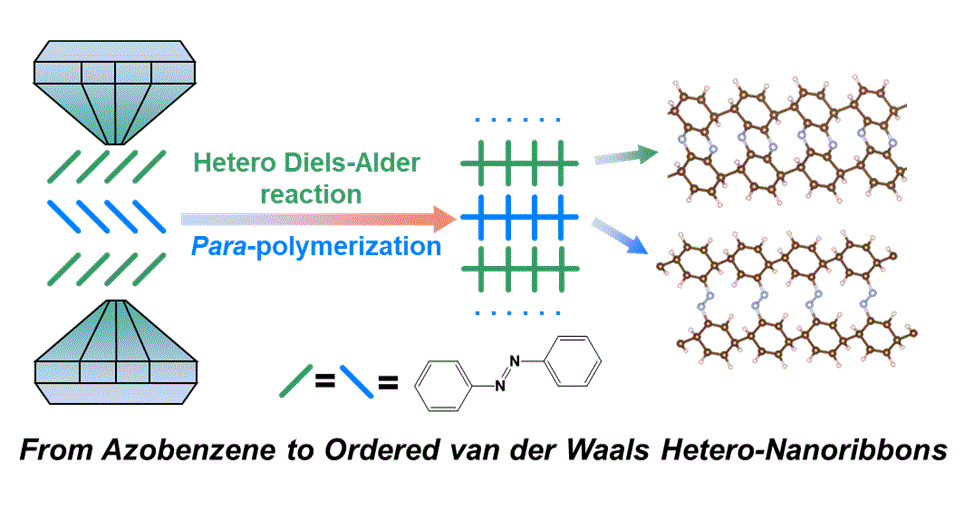The first design and synthesis of ordered van der Waals hetero-nanoribbons via pressure-induced topochemical polymerization of azobenzene – Drs. Peijie Zhang, Dexiang Gao, Haiyan Zheng and Kuo Li.
MARCH 20, 2023
New work from a team of scientists led by Drs. Haiyan Zheng and Kuo Li from the Center for High Pressure Science and Technology Advanced Research (HPSTAR) synthesized ordered van der Waals hetero-nanoribbons via pressure-induced topochemical polymerization of azobenzene. The result is published recently in the Journal of the American Chemical Society.
Van der Waals (vdW) heterostructure is constructed by two or more materials with distinct chemical compositions, structures or properties. This approach of non-destructively integrating materials, which avoids the drawbacks of lattice matching and processing technologies, has drawn significant interest from researchers in the domains of fundamental physics, chemistry, and materials science. VdW heterostructures are now mainly made by physical transfer, chemical vapor deposition, and self-assembly, however it is still difficult to synthesize bulk atomic-scale ordered heterostructure materials.
Since topochemical polymerization using lattices as templates often starts at the nearest unsaturated atoms between neighbor molecules, the single-component crystals with various molecular stacking hold the promise for designed synthesis of atomic-scale ordered vdW heterostructures from the bottom up. The team demonstrated the pressure-induced topochemical polymerization of azobenzene, which has a crystal with two kinds of molecular stacking (A layer and B layer), and found [4+2] hetero-Diels-Alder (HDA) reactions of phenylazo-phenyl in layer A and para-polymerization of phenyl in layer B above 18 GPa. Different reaction selectivity make the single-component azobenzene transform into an ordered vdW heterostructure composing two kinds of carbon-nitrogen nanoribbons. The energy band structure of this vdW heterostructure has a clear relationship with the highest occupied /the lowest unoccupied occupied molecular orbital of these two kinds of carbon-nitrogen nanoribbons, which demonstrates the great advantage of ordered vdW heterostructure in energy band structure tuning.
This is the first example to produce the vdW heterostructure by using the pressure-induced topochemical polymerization of monomers with different stackings, which provides a novel and fresh perspective on the creation of bulk heterostructure materials.

Media report: https://rmtzx.sciencenet.cn/mixmedia/a/202303/19/WS64171733e4b0e8f8ecff64de.html
